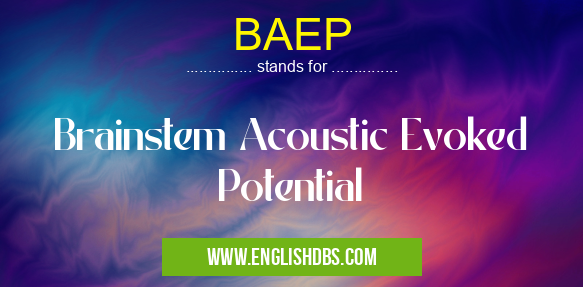What does BAEP mean in UNCLASSIFIED
BAEP stands for Brainstem Acoustic Evoked Potential. It is a neurophysiological test that measures the electrical activity of the brainstem in response to sound stimuli. The test is used to assess the integrity of the auditory pathway, from the cochlea to the brainstem.

BAEP meaning in Unclassified in Miscellaneous
BAEP mostly used in an acronym Unclassified in Category Miscellaneous that means Brainstem Acoustic Evoked Potential
Shorthand: BAEP,
Full Form: Brainstem Acoustic Evoked Potential
For more information of "Brainstem Acoustic Evoked Potential", see the section below.
What is BAEP?
BAEP is a non-invasive test that is performed by placing electrodes on the scalp. The electrodes record the electrical activity of the brainstem in response to a series of clicks or tones that are presented through headphones.
The BAEP waveform consists of a series of five or more waves, each of which represents the activity of a different part of the auditory pathway. The waves are labeled I-V, with wave I representing the activity of the cochlea, wave II representing the activity of the auditory nerve, and waves III-V representing the activity of the brainstem.
Clinical Uses of BAEP
BAEP is used to assess the auditory pathway in a variety of clinical settings, including:
- Hearing loss: BAEP can be used to diagnose hearing loss, particularly in cases where traditional hearing tests are not possible or reliable.
- Brainstem lesions: BAEP can be used to detect lesions in the brainstem, such as tumors, strokes, or multiple sclerosis.
- Monitoring: BAEP can be used to monitor the auditory pathway during surgery or other medical procedures that may affect hearing.
Advantages of BAEP
BAEP offers several advantages over other methods of assessing the auditory pathway, including:
- Non-invasive: BAEP is a non-invasive test that does not require any injections or anesthesia.
- Objective: BAEP is an objective test that does not rely on the patient's subjective responses.
- Sensitive: BAEP is a sensitive test that can detect even small changes in the auditory pathway.
- Reliable: BAEP is a reliable test that can be repeated multiple times to obtain consistent results.
Essential Questions and Answers on Brainstem Acoustic Evoked Potential in "MISCELLANEOUS»UNFILED"
What is a BAEP test?
A Brainstem Acoustic Evoked Potential (BAEP) test is a neurophysiological procedure that evaluates the function of the auditory pathways from the cochlea to the brainstem. It involves recording electrical signals generated by the brain in response to auditory stimuli, providing insights into the integrity and functionality of the auditory system.
Why is a BAEP test performed?
A BAEP test is primarily used to detect and diagnose disorders affecting the auditory pathways, including the cochlea, auditory nerve, brainstem nuclei, and auditory tracts. It is commonly employed to assess hearing loss, evaluate the effectiveness of hearing aids or cochlear implants, investigate acoustic neuromas, and detect brainstem lesions or other neurological conditions.
How is a BAEP test conducted?
During a BAEP test, the patient wears headphones and listens to a series of brief clicking sounds. Electrodes are placed on the scalp to record the electrical signals generated by the brain in response to these stimuli. The recorded signals are then amplified, filtered, and analyzed to assess the latency and amplitude of the evoked potentials, which reflect the conduction time and integrity of the auditory pathways.
What are the limitations of a BAEP test?
While BAEP tests are valuable for evaluating auditory function, they have certain limitations. They may not be sensitive enough to detect all hearing disorders, and their interpretation can be affected by factors such as age, gender, and sedation. Additionally, BAEP tests cannot differentiate between conductive and sensorineural hearing loss.
Are there any risks associated with a BAEP test?
BAEP tests are generally considered safe and non-invasive procedures. The electrical stimulation used during the test is typically mild and does not cause any discomfort. However, as with any medical procedure, there is a small risk of skin irritation or other minor side effects.
Final Words: BAEP is a valuable tool for assessing the auditory pathway. The test is non-invasive, objective, sensitive, and reliable. BAEP can be used to diagnose hearing loss, brainstem lesions, and other conditions that affect the auditory pathway.
